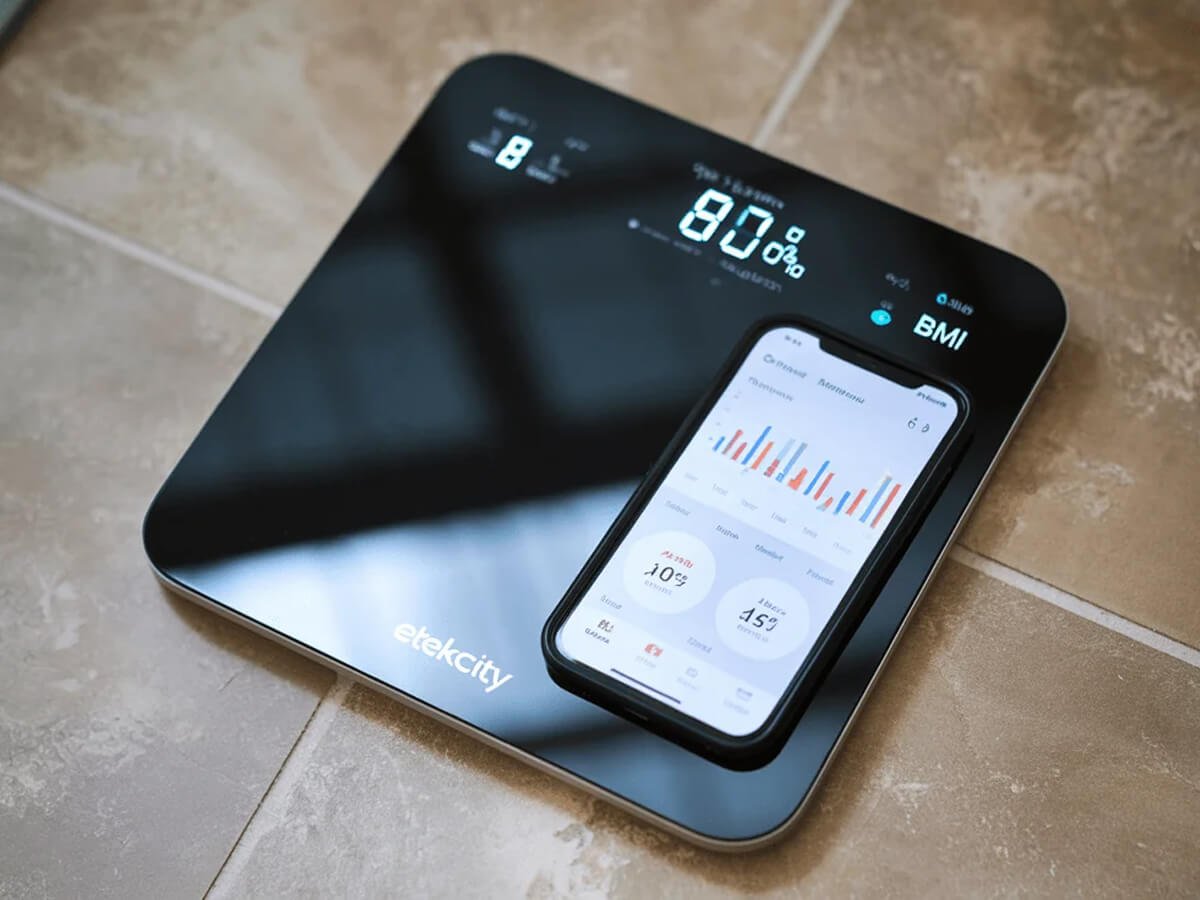Ever stared at a power strip with every slot filled and thought, ‘I still need to plug in my phone’? Frustrating, right? You’re not alone. Thousands of travelers and home office warriors face this electrical gridlock daily, which is exactly why understanding what is a multi plug adapter is can be a game changer.
That’s where a multi-plug adapter swoops in to save your sanity. These compact power heroes let you turn one outlet into many, often adding international compatibility for globetrotters.
I’ve tested dozens of these adapters across three continents, and let me tell you, not all multi-plug adapters are created equal. Some are basically fire hazards with a warranty, while others are engineering marvels that’ll outlast your smartphone.
But here’s what nobody tells you about choosing the right one…
Table of Contents
ToggleUnderstanding Multi-Plug Adapters
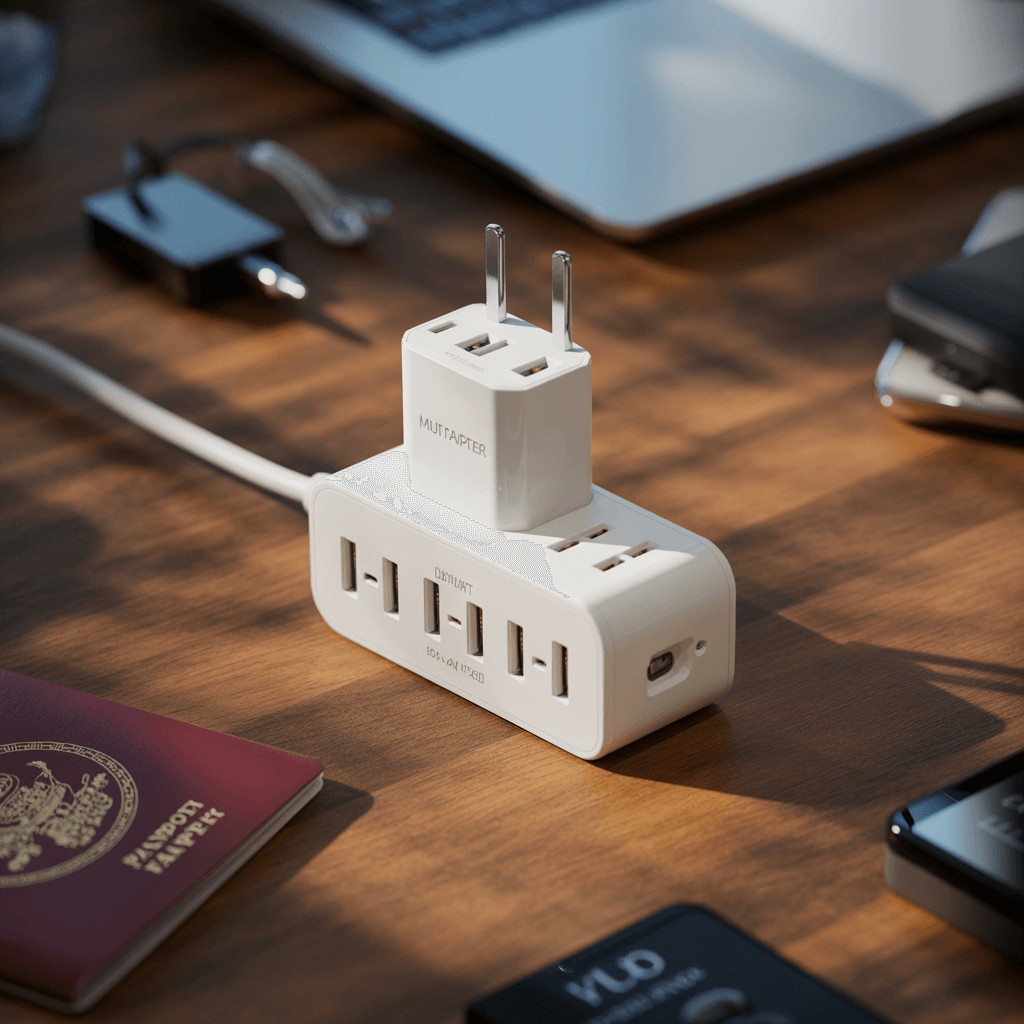
What Is a Multi Plug Adapter and How It Works
A multi-plug adapter, also known as a power strip, outlet extender, or extension socket, is an electrical device that allows multiple electrical appliances or gadgets to connect to a single power outlet. These compact devices are designed to expand the number of available electrical outlets in a convenient and space-efficient manner. The basic function of a multi-plug adapter is to distribute power from one wall outlet to several devices simultaneously, making it an essential tool in homes, offices, and workshops where outlet access is limited.
Multi-plug adapters work like multi-socket adapters, enabling users to link several devices to an individual power source. This functionality is particularly useful when there aren’t many outlets accessible or when devices need to be clustered together in a specific area.
Benefits of Using Multi-Plug Adapters
Multi-plug adapters offer numerous advantages that make them indispensable in our increasingly device-dependent world:
Convenience: They allow you to power multiple devices without constantly unplugging and swapping connections. This is especially helpful in workspaces, bedrooms, or family rooms where simultaneous charging of laptops, phones, and other devices is needed.
Space-saving: Their compact design helps efficiently manage power requirements without using multiple extension cords, reducing clutter and creating a neater environment.
Cost-efficiency: Purchasing a multi-plug adapter is typically more economical than buying several power strips or installing additional wall outlets. They provide multiple outlets and sometimes USB ports at a fraction of the cost.
Portability: Many models are lightweight and compact, making them ideal for travel. They allow you to charge multiple devices simultaneously in hotel rooms, airports, or other locations where outlets may be limited.
Energy efficiency: By organizing all your charging points in one location, multi-plug adapters make it easier to monitor power usage and unplug devices when not in use, potentially reducing energy waste.
Key Features and Components
Modern multi-plug adapters come with various features and components designed to enhance functionality and safety:
Multiple AC outlets: The primary component is a series of standard electrical outlets that allow you to connect various devices. These outlets may be spaced to accommodate larger plugs or adapters.
USB ports: Many contemporary models include built-in USB and USB-C ports for directly charging smartphones, tablets, and other USB-powered devices without requiring separate wall adapters. This saves the standard AC outlets for larger devices.
Surge protection: Higher-quality multi-plug adapters include surge suppression technology that diverts excess voltage away from connected devices during power fluctuations, protecting expensive electronics from damage. These often include indicator lights to show if the protection is working.
Safety features: Most quality multi-plug adapters include built-in safety mechanisms such as overload protection, short-circuit protection, and fire-resistant materials to prevent electrical accidents.
On/off switch: Many models feature a master power switch that allows you to completely cut power to all connected devices without unplugging the adapter itself.
Cord length: For models that include a cord (extension cord type), the length varies to accommodate different placement needs. Some feature flat cords designed to fit under carpets or furniture.
By understanding these key aspects of multi-plug adapters, you can make informed decisions about which type best suits your specific power management needs.
- 【12 IN 1 Power Strip & 2.2 IN Wide Space】- 3-side design power strip surge protector with 8AC widely outlets and 4 USB (…
- 【2 x USB C Power Strip】- Added extra 2 USB C ports for your devices, the USB C port can charge up to 5V/3A. USB-A ports …
- 【Overload Surge Protection】- The surge protector power strip with overload protection protects your electrical appliance…
What Is a Multi Plug Adapter and Its Different Types
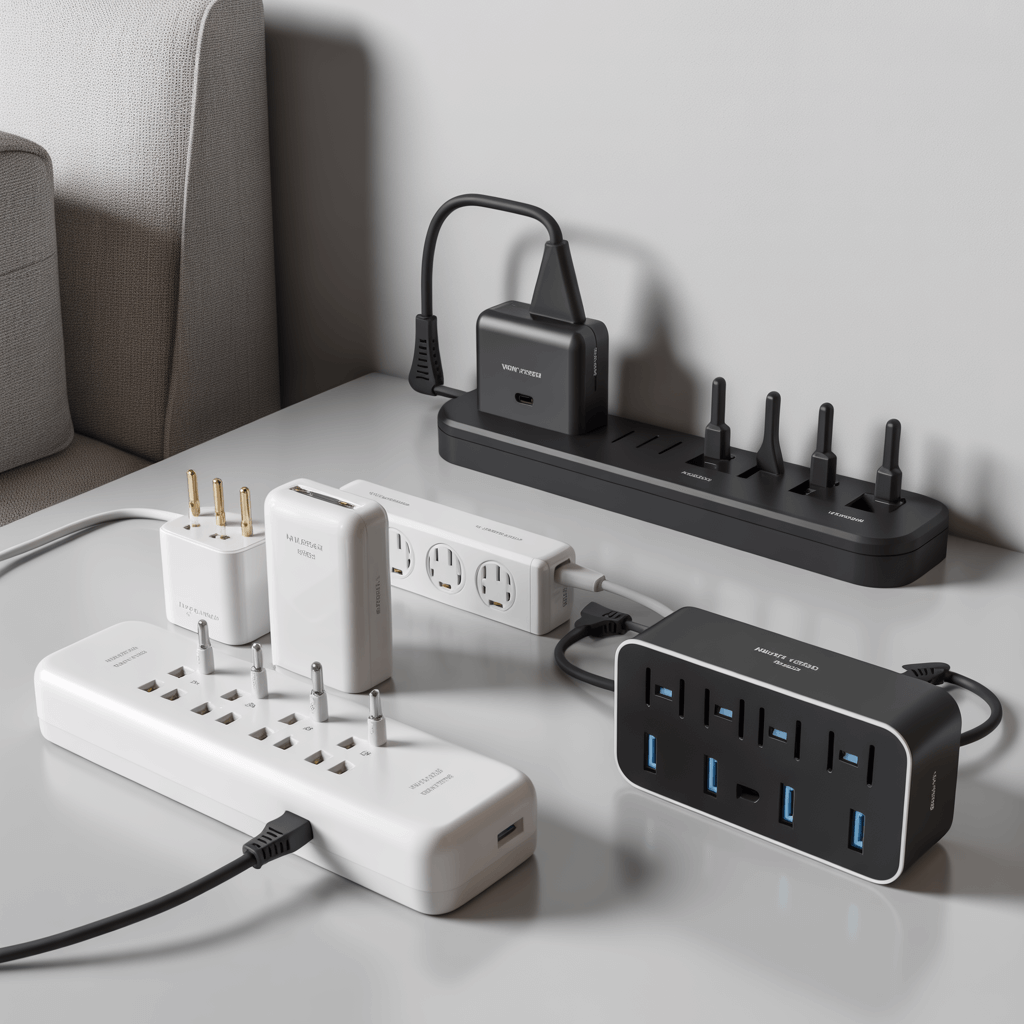
A. Standard Multiplug (Wall-Mounted)
Wall-mounted multi-plugs are designed to be installed directly on the wall, eliminating floor clutter while providing multiple outlets from a single power source. These compact devices offer several key benefits:
- Space Efficiency: They free up valuable floor space by mounting directly to your existing outlet
- Enhanced Safety: Reduced risk of tripping over cords, making them safer for households with children or pets
- Organization: Creates a tidier and more organized workspace or living area
- Convenience: Allows you to connect several devices without requiring additional power outlets
Wall-mounted multi-plugs are particularly useful in areas with limited space, such as small apartments, dorm rooms, or cramped office environments, where keeping the floor clear of cords is a priority.
B. Extension Cords with Multi-Outlets
Extension cords with multiple outlets extend the reach of your power supply while providing several connection points for your devices. These versatile options offer:
- Extended Reach: Ideal for accessing hard-to-reach outlets or positioning devices away from wall outlets
- Multi-Device Support: Allows you to power various devices simultaneously from a single source
- Portability: Easily movable to different locations as your needs change
- Flexibility: Can be routed around furniture or obstacles to deliver power where needed
These are particularly valuable when you need to power devices that are spread across a room or when wall outlets are inconveniently located.
C. Power Strips with Surge Protection
Power strips are multi-outlet devices that not only provide additional outlets but often come equipped with built-in safety features. Key advantages include:
- Extra Outlets: Provides multiple outlets from a single power source
- Surge Protection: Helps maintain steady voltage by absorbing excess power during voltage spikes
- Device Longevity: Protects your expensive electronics from damage caused by power surges
- Data Protection: Prevents data loss on computers and storage devices during electrical fluctuations
- Functional Design: Many models feature spaced outlets to accommodate larger plugs
In areas prone to power fluctuations or load shedding, surge-protected power strips are essential for safeguarding valuable electronics and extending their lifespan.
D. Travel and Universal Adapters
Travel adapters and universal adapters allow you to use your devices in foreign countries with different outlet configurations. These portable solutions offer:
- International Compatibility: Works with plugs from various countries and regions
- Travel-Friendly Design: Compact and lightweight, making them essential for frequent travelers
- Universal Compatibility: Universal adapters work with multiple plug types from different regions
- Convenience: Eliminates the need to purchase separate chargers for international travel
- Versatility: Many travel adapters include USB ports for charging mobile devices directly
Some advanced travel adapters also include USB ports and even USB-C connections for charging smartphones and tablets without requiring separate plug adapters, making them all-in-one solutions for the modern traveler.
- 【12 IN 1 Power Strip & 2.2 IN Wide Space】- 3-side design power strip surge protector with 8AC widely outlets and 4 USB (…
- 【2 x USB C Power Strip】- Added extra 2 USB C ports for your devices, the USB C port can charge up to 5V/3A. USB-A ports …
- 【Overload Surge Protection】- The surge protector power strip with overload protection protects your electrical appliance…
Multi Plug Adapter Function and Safety Considerations
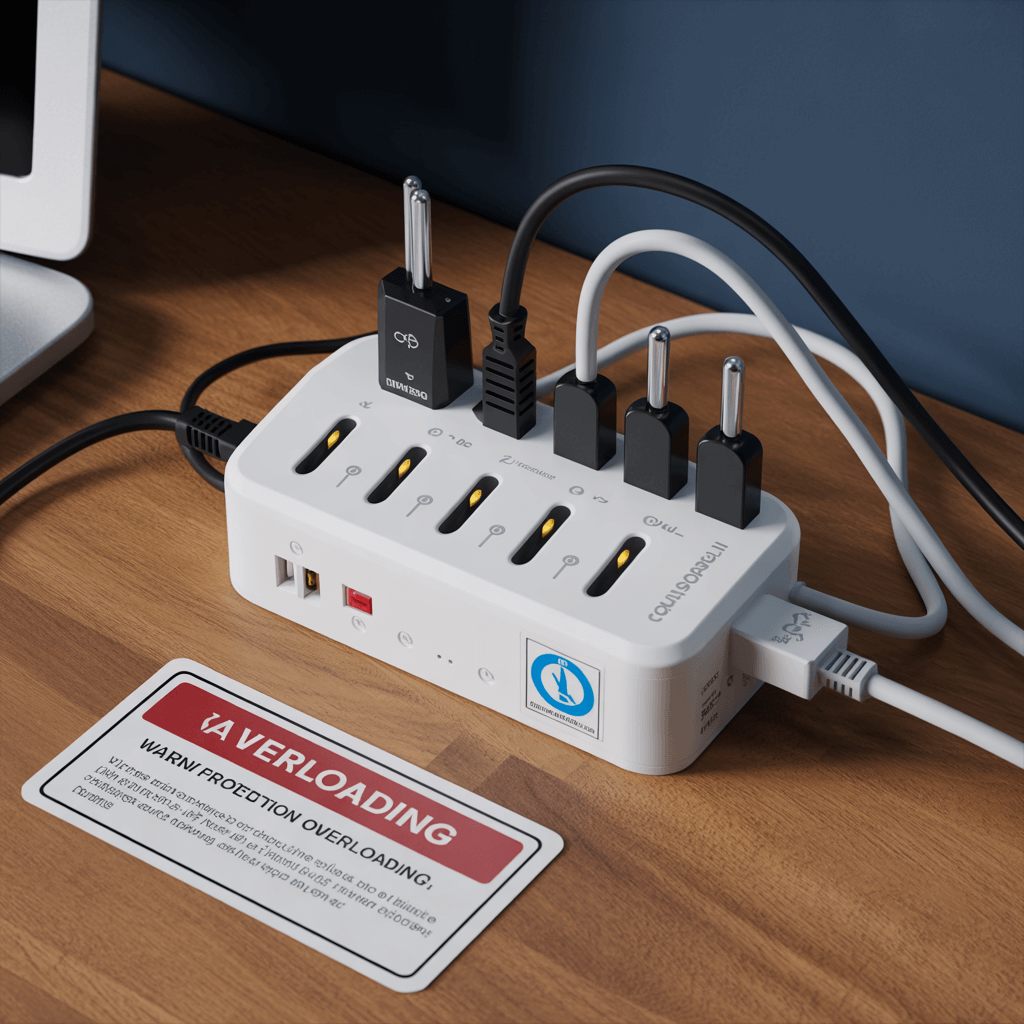
Electrical Load Capacity and Overload Prevention
Multi-plug adapters have a maximum load capacity that must be respected to prevent electrical hazards. Each power outlet is designed to handle a specific amount of electricity, typically 13 amps in most household circuits. When using a multi-plug adapter, the combined power draw of all connected devices must not exceed this limit.
Overloading occurs when the total amperage of connected devices surpasses the capacity of the adapter or wall outlet. For example, if you connect two appliances with 13-amp ratings to a single adapter, you’re creating a dangerous 26-amp load on a system designed for only 13 amps. This excessive current can cause overheating, potentially leading to electrical fires.
To prevent overloading:
- Calculate the total amperage of all devices before connecting them
- Choose adapters with built-in overload protection features
- Prioritize power boards with safety switches over simple double adapters
- Consider installing additional permanent power points for high-demand areas
Child-Proof Features and Protection
Modern multi-plug adapters often incorporate child safety features to prevent accidental contact with live electrical components. These may include:
- Plastic safety covers for unused outlets
- Recessed socket designs that make it difficult for small fingers to reach live pins
- Shuttered socket mechanisms that only open when a proper plug is inserted
When selecting adapters for households with children, prioritize models with these protective features to minimize the risk of electrical shocks and injuries.
Fire Hazards and Prevention Measures
Multi-plug adapters can become significant fire hazards when not used properly. Common fire risks include:
- Overheating due to excessive current draw
- Poor connections create resistance and heat buildup
- Dust accumulation is interfering with proper heat dissipation
- Physical damage to adapters, exposing internal wiring
To prevent fire hazards:
- Regularly inspect adapters for signs of damage, discoloration, or melting
- Ensure proper ventilation around adapters and avoid covering them
- Never “daisy-chain” multiple adapters together
- Replace old or damaged adapters immediately
- Avoid using adapters with heavy transformers that might become dislodged
How a Multi Plug Adapter Works: The Role of Polarization and Earthing
The proper polarization and earthing of multi-plug adapters are crucial safety elements that should not be overlooked. Earthing provides a safe path for electricity to flow in case of a fault, protecting users from electric shocks.
Key considerations include:
- Ensuring adapters maintain proper polarity to prevent incorrect connections
- Using only adapters that preserve the earth connection from the original outlet
- Avoiding the use of adapter plugs that convert three-pin plugs to two-pin configurations
- Understanding that earthing is especially important for metal-cased appliances
For optimal safety, choose power boards with surge protection that include proper earthing connections rather than basic double adapters. These provide additional protection against power surges and maintain the integrity of the electrical safety system.
When using multi-plug adapters in older buildings or with non-standard outlets, consult with a qualified electrician to ensure that polarization and earthing requirements are properly addressed to maintain electrical safety.
- 【12 IN 1 Power Strip & 2.2 IN Wide Space】- 3-side design power strip surge protector with 8AC widely outlets and 4 USB (…
- 【2 x USB C Power Strip】- Added extra 2 USB C ports for your devices, the USB C port can charge up to 5V/3A. USB-A ports …
- 【Overload Surge Protection】- The surge protector power strip with overload protection protects your electrical appliance…
Standards and Regulations
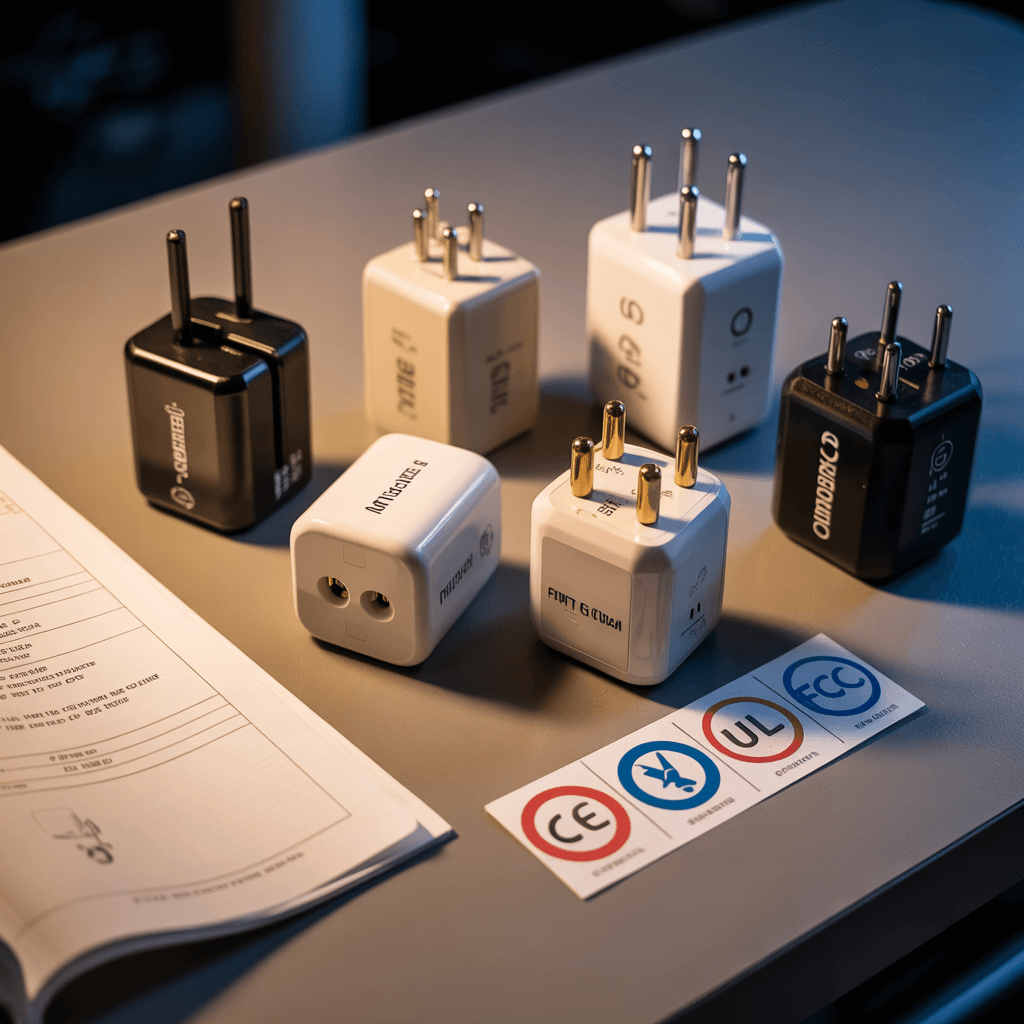
International Electrotechnical Commission (IEC) Standards
The International Electrotechnical Commission (IEC) plays a crucial role in establishing global standards for electrical plugs and sockets. The IEC maintains a comprehensive guide with letter designations for generally compatible types of plugs, which serves as a de facto naming standard and reference guide for travelers worldwide. These letter designations (Types A through O) help identify plug configurations across different regions, making it easier to determine compatibility when traveling internationally.
IEC 60906-1, published in 1986, was intended to create a universal plug and socket standard for regions with 230V mains electricity. This specification aimed to harmonize electrical connections across Europe and other regions, though the effort to adopt it as a European Union standard was halted in the mid-1990s. Currently, only South Africa (as SANS 164-2) and Brazil (with modifications as NBR 14136) have officially adopted variations of this standard.
For regions using 120V systems, IEC 60906-2 recommends the use of NEMA 5-15 plugs and sockets, which are commonly found in North America.
Regional Certification Requirements
Different regions have specific certification requirements that manufacturers must meet before electrical products can be sold or used in those markets:
In Europe, CENELEC (European Committee for Electrotechnical Standardization) publishes a list of approved plug and socket technical standards used by member countries. However, CE marking is neither applicable nor permitted on plugs and sockets in the EU, as these items fall under separate regulatory frameworks.
China implemented the Compulsory Product Certification System (CPCS) as part of its WTO entry commitment. Compliant Chinese plugs must earn the China Compulsory Certificate (CCC) Mark through this system before they can be legally sold in the Chinese market.
In the United Kingdom and countries following British standards, plugs must adhere to BS 1363 specifications, which include mandatory safety features such as fused plugs and insulated pins.
Brazilian standards under NBR 14136 became optional for manufacturers in 2007 and compulsory as of January 1, 2010, requiring all devices sold in Brazil to comply with the national standard.
What Is a Multi Plug Adapter: Key Technical Specifications to Consider
When selecting multi-plug adapters, several technical specifications are critical for ensuring safety and compatibility:
Current and voltage ratings: Adapters are typically rated for specific amperage (6A, 10A, 16A, etc.) and voltage (usually 250V). Using an adapter with ratings lower than your device requirements can create safety hazards, particularly for high-current equipment, which could cause fires when connected to inadequately rated adapters.
Safety features: Modern adapters should include protective elements such as:
- Shutters on apertures to prevent foreign object insertion
- Insulating sleeves on pins to reduce shock risk during insertion/removal
- Proper earthing connections for devices requiring grounding
- Protection from overload or short circuits
Pin dimensions and spacing: These critical measurements determine physical compatibility between plugs and sockets. Even minor variations in diameter (e.g., 4.0mm vs. 4.8mm) or spacing can prevent proper connections or create unsafe fits.
Polarization: Some plug systems are designed with polarized connections to maintain consistent live and neutral connections, which can be important for certain appliances where internal switches should interrupt only the live side of the circuit.
Quality adapters should also be tested for durability, pin retention force, temperature rise during operation, and compliance with other performance requirements specified in relevant technical standards.
- 【12 IN 1 Power Strip & 2.2 IN Wide Space】- 3-side design power strip surge protector with 8AC widely outlets and 4 USB (…
- 【2 x USB C Power Strip】- Added extra 2 USB C ports for your devices, the USB C port can charge up to 5V/3A. USB-A ports …
- 【Overload Surge Protection】- The surge protector power strip with overload protection protects your electrical appliance…
Multi Plug Adapter Explained: Navigating Different Plug Types Worldwide
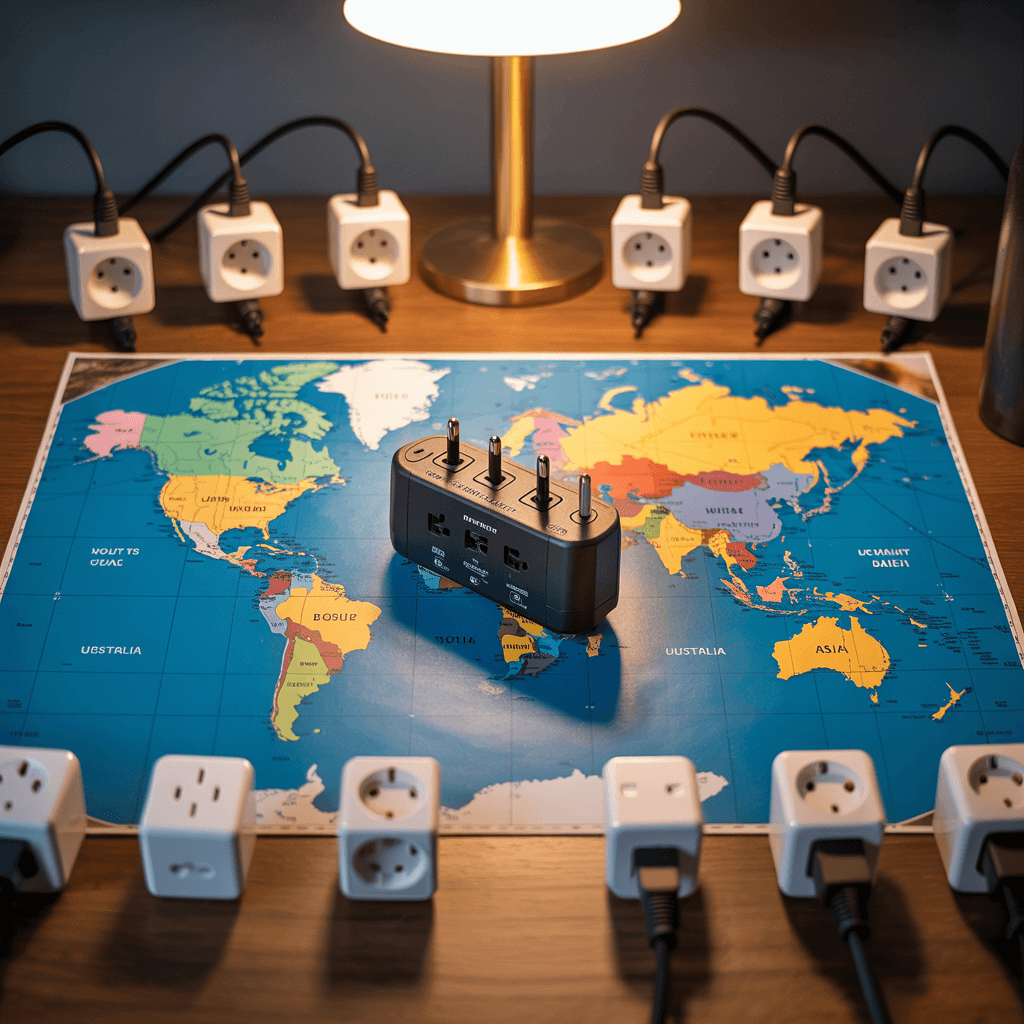
North American Standards (Type A & B)
Type A and Type B plugs are predominantly used in North America, Central America, and parts of South America. The Type A plug features two flat parallel prongs and is ungrounded. The Type B plug adds a round grounding pin below the two flat prongs, providing a safer connection.
These plugs are rated for 15 amps at 125 volts and are used in countries such as the United States, Canada, Mexico, Japan, and Colombia. The Japanese version has slight variations—Japanese plugs generally fit into North American sockets, but polarized North American plugs may require adaptors for older Japanese sockets.
In Japan, the voltage is only 100V, and the frequency varies between 50Hz (Eastern Japan) and 60Hz (Western Japan), which may affect certain North American devices.
European Standards (Type C, E, F)
The Type C plug, also known as the “Europlug,” is one of the most widely used international plugs. It features two round pins and is unground, rated at 2.5A. This plug is designed to work with a variety of European socket types.
Type E sockets are primarily found in France, Belgium, Poland, and several other countries. They have a round recess with two holes and a male earthing pin that protrudes from the socket. The plug has corresponding holes to accommodate this earthing pin.
Type F, also called “Schuko,” is common in Germany, Austria, the Netherlands, and many other European countries. It has two round pins for power and side earthing clips. The system is unpolarized, allowing live and neutral connections to be reversed.
The CEE 7/7 plug is a hybrid design that works with both Type E and Type F sockets, making it versatile across European countries.
British Standard (Type G)
The Type G plug is the main type used in the United Kingdom, Ireland, Malta, Hong Kong, and approximately 50 other countries worldwide. This plug has three rectangular pins forming an isosceles triangle. The distinctive feature of the BS 1363 plug is its built-in fuse, making it one of the safest plug designs globally.
Type G sockets have a standardized polarity: earth is at the top, and the live connection is on the right side of the socket. This convention is followed in all countries using this plug type.
Australian/Chinese Standard (Type I)
Type I plugs are primarily used in Australia, New Zealand, China, Argentina, and parts of the Pacific. They feature two flat pins at an angle (forming a V-shape) and a vertical earthing pin.
While the basic design is similar across these countries, there are important differences:
- In Argentina, the plug is wired with the live and neutral contacts reversed compared to the Australasian and Chinese versions
- Australian standards require insulating sleeves around the upper parts of the power pins for enhanced safety
- Chinese plugs exist in both 10A and 16A versions with different pin dimensions
The Australian/New Zealand standard defines a series of plugs and sockets for devices drawing up to 10, 15, 20, 25, and 32A that are one-way compatible, meaning sockets accept plugs of equal or lower current ratings.
Other Regional Standards
Several other significant plug standards exist around the world:
Type J: Used in Switzerland and Liechtenstein, it has three round pins with the earthing pin offset. Swiss sockets accept both Type J plugs and Europlugs.
Type K: The Danish standard featuring two round pins with an earthing pin that forms part of the plug rather than the socket.
Type L: Of Italian origin, it comes in 10A and 16A versions that differ in pin dimensions. Both are symmetrical, allowing live and neutral contacts to be inserted in either direction.
Type N: Used in Brazil and South Africa, based on IEC 60906-1 specification with three round pins.
Type O: Unique to Thailand, it has two round power pins and an earthing pin, compatible with both NEMA and Europlug designs.
- 【12 IN 1 Power Strip & 2.2 IN Wide Space】- 3-side design power strip surge protector with 8AC widely outlets and 4 USB (…
- 【2 x USB C Power Strip】- Added extra 2 USB C ports for your devices, the USB C port can charge up to 5V/3A. USB-A ports …
- 【Overload Surge Protection】- The surge protector power strip with overload protection protects your electrical appliance…
What Is a Multi Plug Adapter and How to Choose the Right One
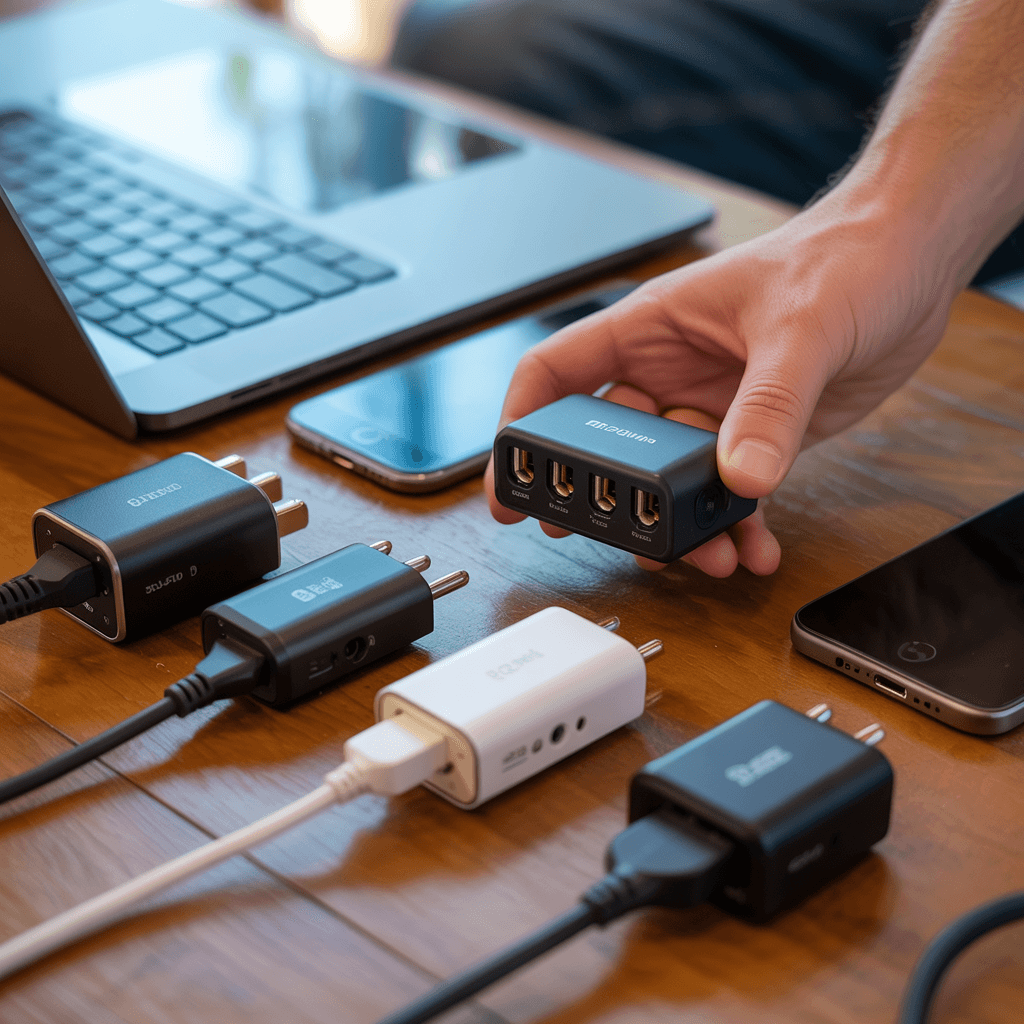
A. Assessing Your Power Needs
Before purchasing a multi-plug adapter, it’s crucial to evaluate your specific electrical requirements. Consider how many devices you’ll need to power simultaneously and their individual power demands. High-powered appliances like heaters or kitchen devices require more electricity than phones or tablets.
Measure the distance between your wall outlet and where you’ll place your devices to ensure the adapter’s cord length is sufficient. For travelers, research the specific plug types needed for your destinations, as universal adapters aren’t truly universal and may not work in every country.
Check the voltage specifications of your devices. Most modern electronics like phones, laptops, and cameras are multi-voltage (100-240V) and will work with just an adapter. However, single-voltage items like older hair dryers may require a voltage converter.
B. Special Features to Consider
When selecting a multi-plug adapter, look for these valuable features:
- Replaceable fuses: Adapters with replaceable fuses offer better protection against power surges. Some even include spare fuses.
- Locking mechanisms: Adapters with sliders that lock securely in place provide more stability and safety.
- Maximum power output: Higher maximum output (measured in amps) means faster charging for multiple devices simultaneously.
- Build quality: Plastic-on-plastic construction is common, but look for models that feel sturdy and well-constructed.
- Size and weight: Consider the adapter’s bulk, especially for travel. Universal adapters are convenient but larger than individual plug adapters.
C. USB and Smart Charging Options
Modern multi-plug adapters often include USB ports for direct device charging without needing separate wall chargers. When evaluating these options:
- Number of USB ports: Some adapters offer up to five ports (four USB-A and one USB-C), allowing you to charge multiple devices at once.
- Charging speed: Check the maximum output per port and total output. The best adapters provide at least 2.4 amps per USB-A port and 3 amps for USB-C ports.
- Smart charging technology: Some adapters include intelligent chips that automatically adjust charging speed based on your device’s requirements.
- LED indicators: Look for non-distracting LED indicators that confirm the adapter is working without being bright enough to disturb sleep.
D. Quality and Durability Factors
The durability of your multi-plug adapter is vital for both safety and longevity:
- Materials: Quality adapters use fire-resistant materials and have robust internal components.
- Safety certifications: Look for adapters with recognized certifications like UL (Underwriters Laboratories), ETL (Intertek Testing Services), or CE (Conformité Européenne).
- Overload protection: Features like over-current, over-voltage, and short-circuit protection help prevent damage to your devices.
- Case or pouch: Some adapters include protective cases that prevent damage during travel and keep components organized.
- Warranty: A warranty indicates the manufacturer’s confidence in their product’s durability.
Remember that even the best adapters aren’t built to last forever. Their convenience and functionality make them worthwhile investments, but expect to replace them periodically, especially with frequent use or travel.
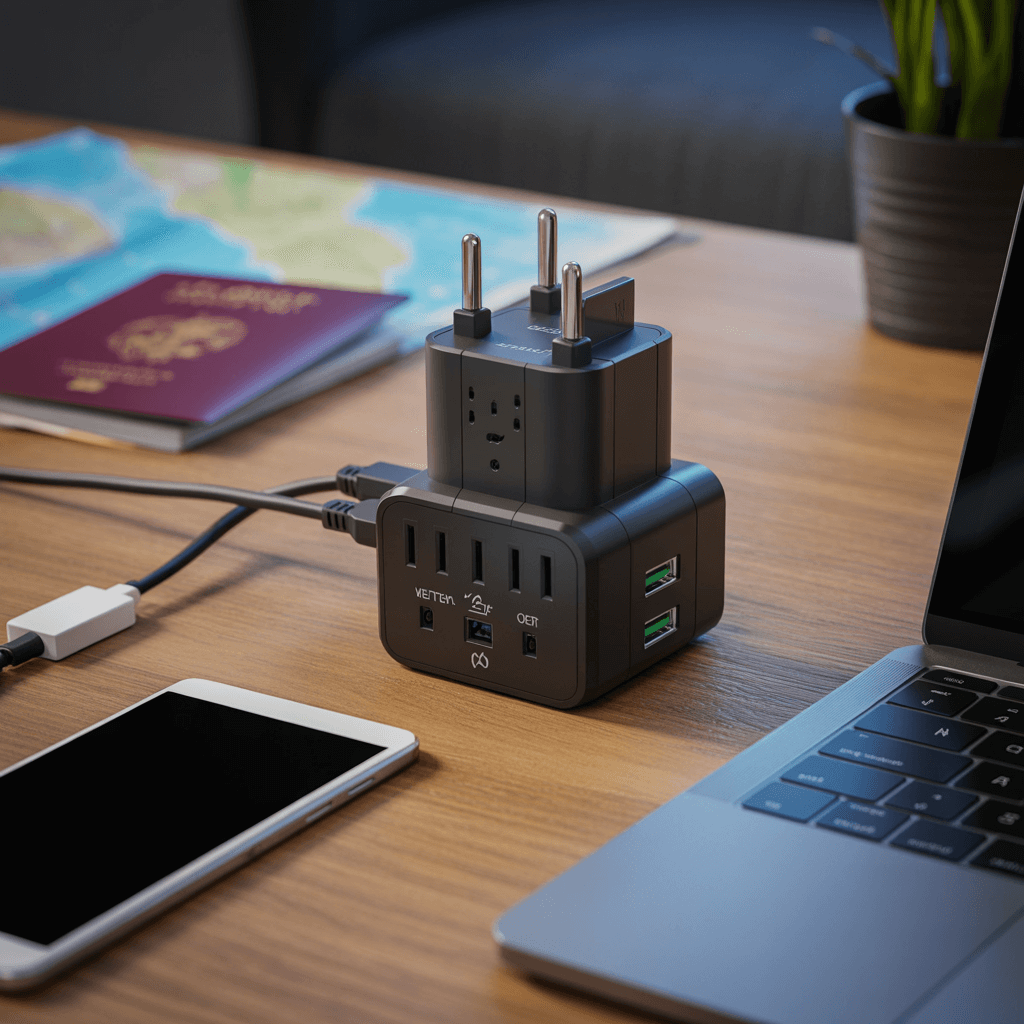
Multi-plug adapters are essential tools for modern connectivity, allowing you to transform a single outlet into multiple power sources. Whether you need a basic power strip for home use, a surge protector for valuable electronics, or a travel adapter for international journeys, understanding the different types and their safety features is crucial. Always check for proper certification, voltage compatibility, and amperage ratings to protect your devices and ensure safe operation.
When selecting the right adapter for your needs, consider where you’ll be using it, what devices you’ll be connecting, and the electrical standards of your destination country. Investing in a quality multi-plug adapter not only provides convenience but also safeguards your valuable electronics. Remember that proper usage—avoiding overloading and daisy-chaining—will extend the life of your adapter and maintain a safe electrical environment.
- 【12 IN 1 Power Strip & 2.2 IN Wide Space】- 3-side design power strip surge protector with 8AC widely outlets and 4 USB (…
- 【2 x USB C Power Strip】- Added extra 2 USB C ports for your devices, the USB C port can charge up to 5V/3A. USB-A ports …
- 【Overload Surge Protection】- The surge protector power strip with overload protection protects your electrical appliance…
This is Trending Products Zone. Trending Products Zone is a participant in the Amazon Services LLC Associates Program and other affiliate programs, such as the Costco Affiliate Program and, AliExpress Affiliate Program, designed to provide a means for websites to earn advertising fees by advertising and linking to partner sites. As an affiliate site, we may earn commissions from qualifying purchases made through links on our website, at no additional cost to you.






